Hotel Königstuhl, Heidelberg
last update: 23 November 2022
This webpage is a hotel review, but it includes also a description and review of some typical of Germany dishes that you might find in a traditional Bergstube. A stube is a room for living in, often the heated part of a traditional farmhouse. And in this case our stube sits on a hill top (berg).
In late 2022 we were in Heidelberg for four days, and could not identify a good hotel near the Mathematikon in the university's Neuenheimer Feld district, so we decided to stay at the 4-star Hotel Berggasthof Königstuhl which is on the summit of the Königstuhl, and sitting above the Heidelberg Castle. The hotel was about a 30 minute taxi ride from Mathematikon, approx. 9-10 km away (price around €30 including tip).
Contact with the hotel was professional, and we learned that they had private parking, a local restaurant, and rooms with walk-in showers, but did not offer room service. One nice feature was that the restaurant opened at 17:00.
Finding the hotel

We can see that there is a series of winding roads that lead up and past the hotel location, but it was not so easy to find.
Firstly, the Mercedes GPS navigation system did not recognise the address, despite Google Maps having a detailed driving route directly to the hotel. I had to input a nearby road to get the Mercedes system up and running.
Secondly, the "best" route picked by the Mercedes system was closed due to roadworks. Fortunately, when backing out a local lady gave us new directions, i.e. back to the main road below and take the next road up the hill. Luckily I had rediscovered my rusty German.
Thirdly, despite having a target address, the Mercedes system refused to focus down to the 50 meters, so it became difficult to understand if "next bear right" was immediately or slightly later. Fortunately a kind couple who were driving down the hill took pity on us, and they turned around and took us up the hill to the final turning to the hotel access road. My rusty German again proved useful.
The real problem was that we arrived early evening, and with the poor visibility, the drizzling rain, the lack of road lighting, and the almost inexistent signposting, it was very difficult to find the right route up to the hotel. During the day it would probably have been much easier.
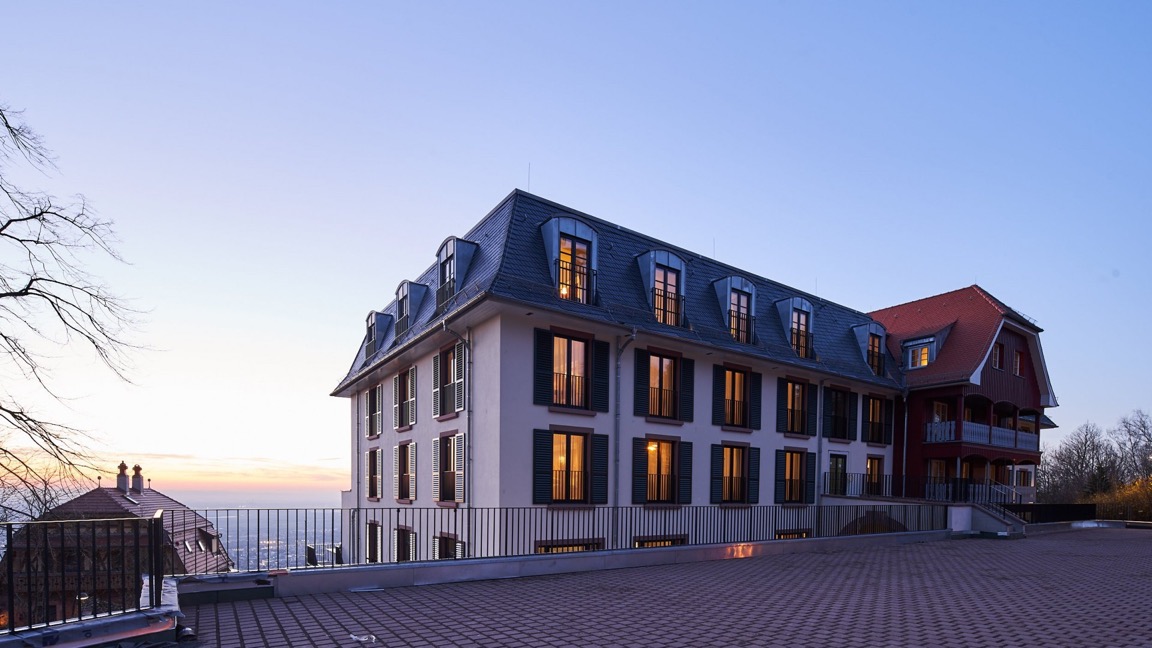
I must admit the hotel and the parking, viewed in early evening, through the drizzle, was not particularly welcoming. We parked and had to walk down and around to the far side to find the hotel entrance, which fortunately was bright, warm and welcoming.
In fact the open parking is situated on top of the covered parking. This private parking (€15 per day) is not integrated into the hotel itself, but it's just a few metres to walk through to the hotel reception area.
Königstuhl and its Bergbahn
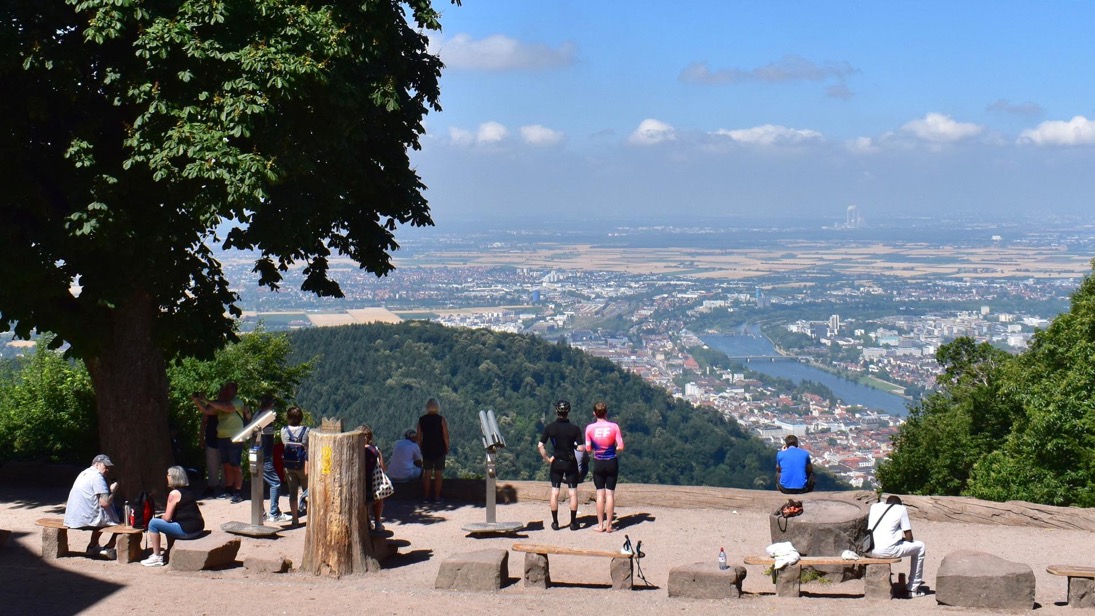
The 567.8 meter high Königstuhl is the highest mountain in the Kleiner Odenwald. Above we have the view from the top terrace, and also at the top there is the upper station of the Heidelberger Bergbahn, a two-section funicular railway.

The two sections are quite different, the lower section (Molkenkurbahn) is a modern design, whereas the upper section (Königstuhlbahn) uses wooden bodied cars of historical appearance. The upper stations are also of the original design dating back to 1907. This upper section is about 1 km long, rises about 260 metres (up to the top), and at times the steepness approaches 41%. And the upper station is right next to our hotel.

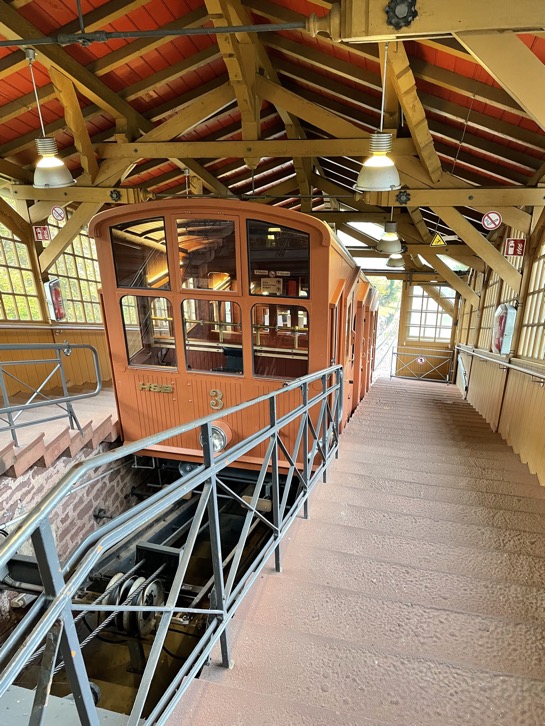
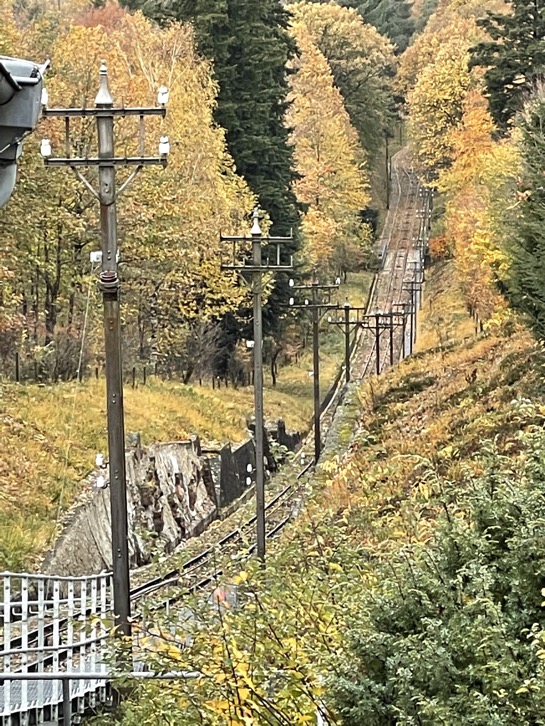
A hotel with a history
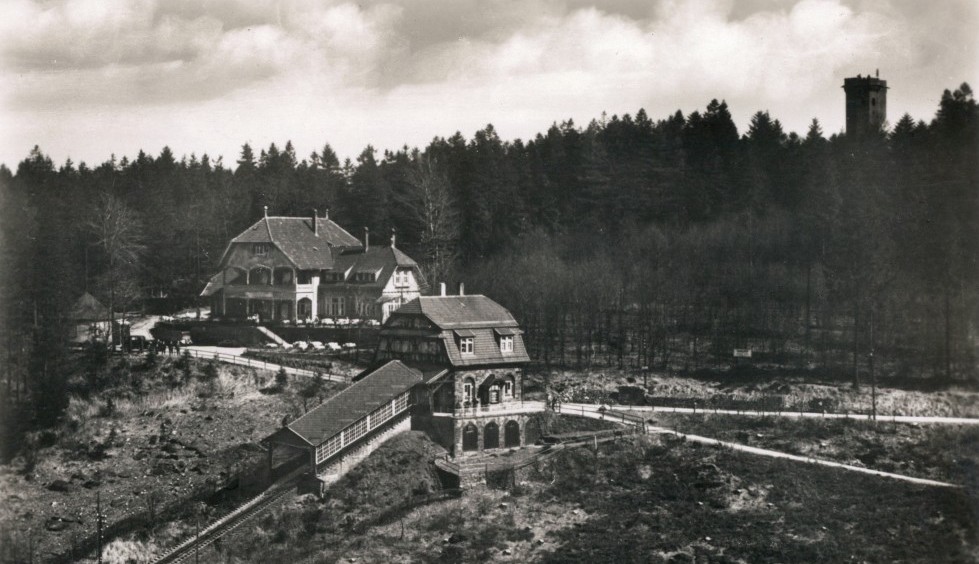
Since 1864 there has always been a hotel directly behind a popular viewing platform on the Königstuhl, near the summit station of the Bergbahn.
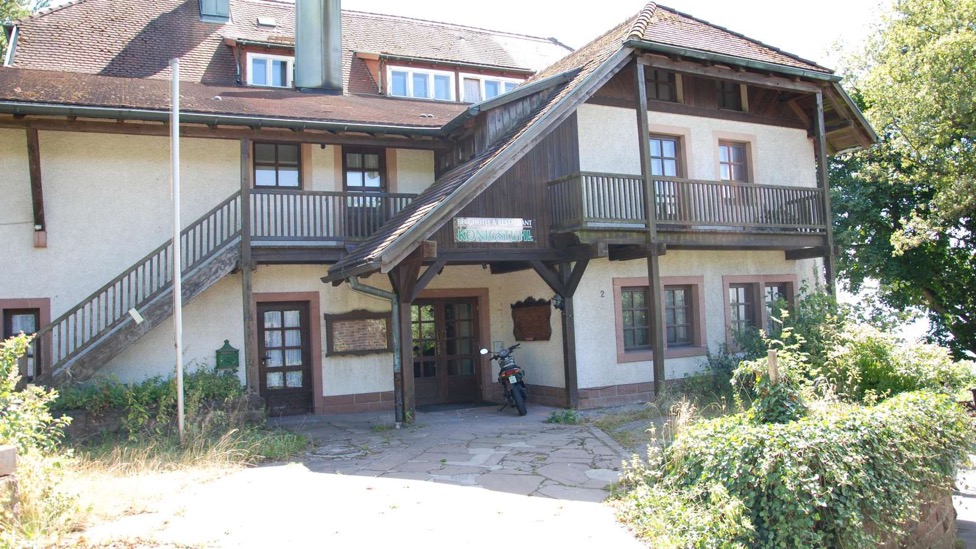
The building on the Heidelberg Königstuhl, with its pretty terrace and twelve guest rooms, was once a popular destination. But it fell into disrepair, and was closed in 2009. Many plans were made, but all failed in the preparatory phase.
Just before Christmas 2012 new investors took over the hotel, and in June 2013 they had reopened the beer garden as the first stage of a comprehensive renovation.
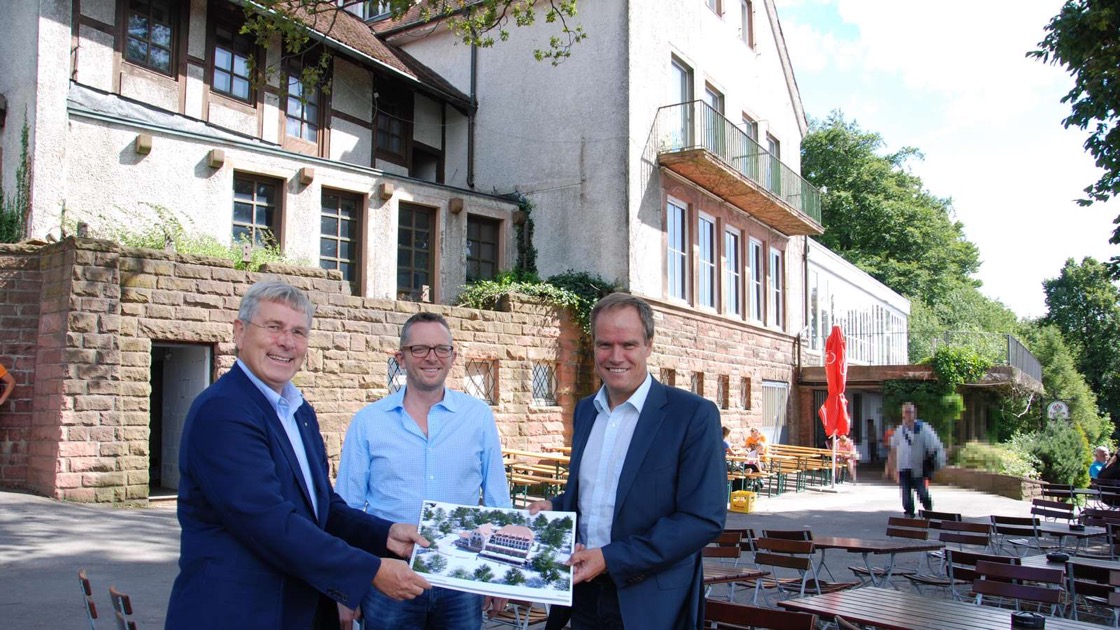
The aim was that by mid-2014 the outside of the listed building would once again resemble the mountain inn from 1904. The building was to be restored to its old condition. No larger extensions were planned, the focus was rather on the elimination of old building defects. It took a little longer than originally planned but the idea was that there would be two levels, on the lower level a beer garden and a restaurant with a terrace at the level of the cable car station and above that conference, banquet and event rooms. The upper floors would have 30 to 40 rooms for overnight guests.
The idea of a new construction project and the approval process dragged on for years. Already in 2008, the city had given the then owner a building permit for an extension to the south of the existing building. The new owners then received a new building permit for conversion and extension in 2014. Changes were approved five times up until 2017, when it was finally realised that the building fabric was too dilapidated to be renovated. So in October 2018 permission was granted for everything to be demolished and completely rebuilt.

Above we have the partially demolished remains of the old hotel in October 2017, and below we can see the construction site in September 2019.
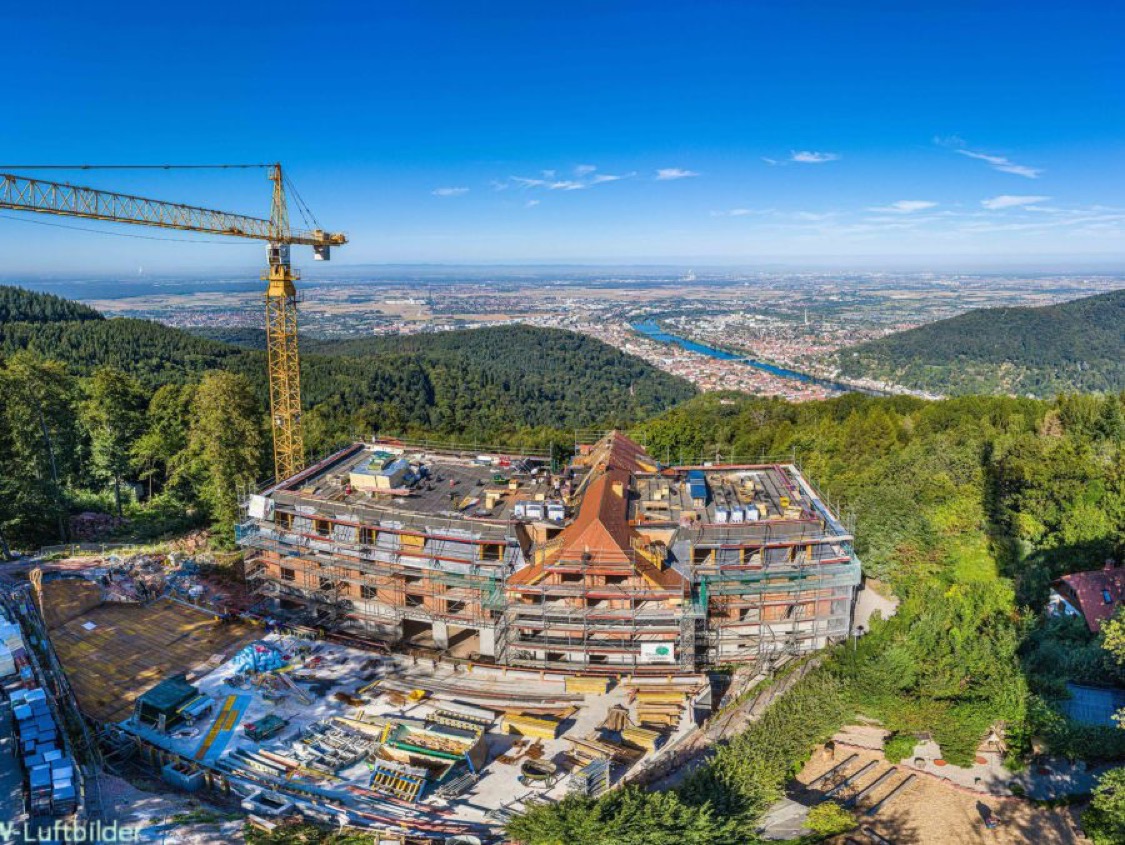
As far as I can tell the older hotel had one floor less and was about three meters smaller in overall height. After the building permit of October 2018 the old hotel was completely demolished. The new building was significantly bigger than the previous building. The original approval for the demolition and new construction was later declared illegal and should not have been granted by the city. The reality was that the dimensions of the new building were too large in the landscape protection area. It's true that by 2018 the existing building was no longer protected. It was noted that buildings that were destroyed by fire or other natural phenomena could be rebuilt on the same site, but this was not true for the "gradual decay of a building". However it was argued that whilst the height and the architectural design of the new building did differ significantly from the original building, nevertheless it blended in better with the landscape. Also it was argued that the building might impair the landscape, but it did not "deface" it, and as such it was still allowable in terms of nature conservation. Finally, given that the hotel was almost completed, it was decided not to order its demolition, i.e. remembering that the owners had received a valid building permit, albeit later considered illegal.
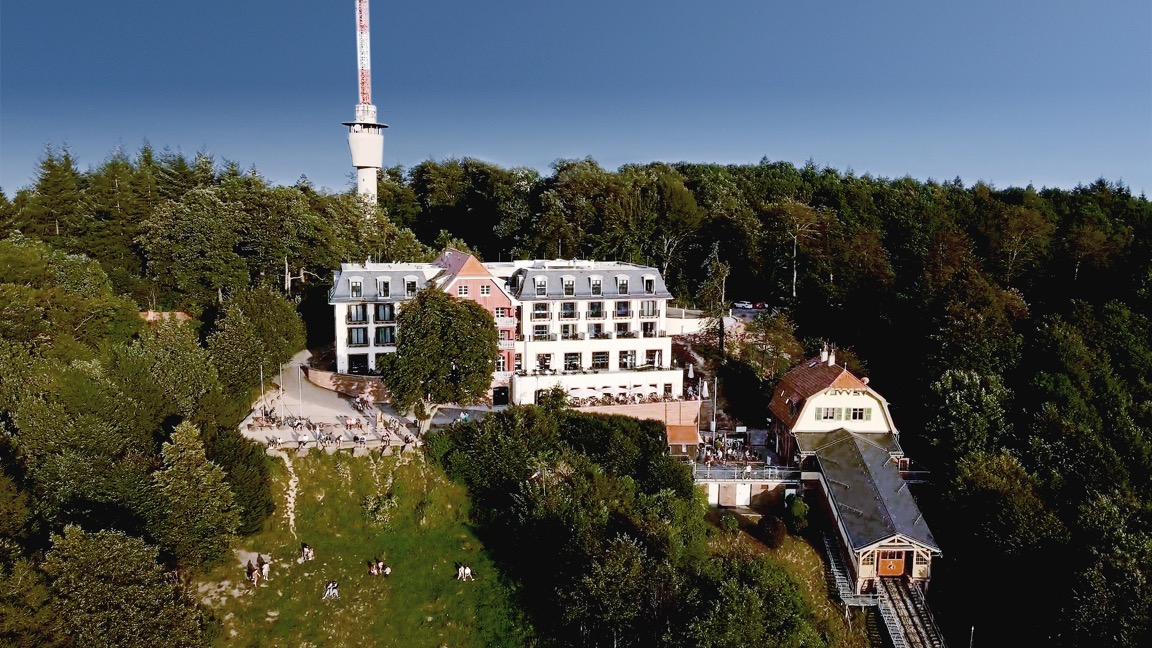
Despite the fact that the 4-star hotel was ready for occupancy at the end of 2020, with 62 fully furnished rooms, it only opened on the 21 June 2021.
Our hotel room
The simplest rooms cost €123, excluding breakfast (cost €19), whilst we went for a suite with a city view, costing €203/night. Key elements included an extra-large double bed, and a good sized terrace with a city view (not very useful because it was cold and it rained almost all the time). Since we were spending 4 nights in Heidelberg we looked for good secure parking, a terrace, a view, a good sized room with a sitting area, a walk-in shower, wall-safe, and a good free wifi connection. We booked directly with the hotel, but were comforted by the fact that Booking rated it as 8.9 Fabulous (1,269 reviews), and highlighted that not only did the room have hardwood floors and a wardrobe, but the hotel also provided towels and even toilet paper! Oddly, Tripadvisor only gave it a very good 4 (but based upon only 23 reviews), and rated it 52nd of 79 hotels in the city.
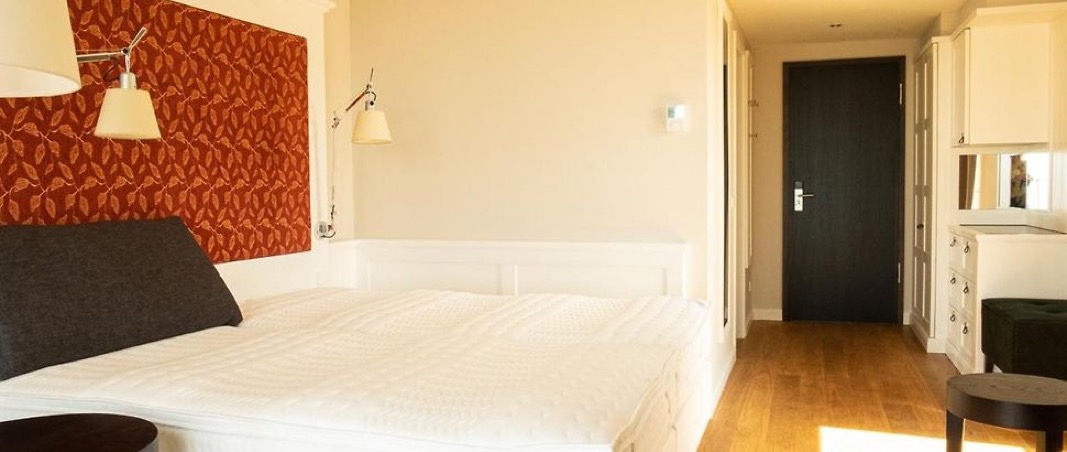
Entering the room in the evening meant that we didn't have the full impact of the panoramic view of the terrace and city below. I would have liked to see a bit more colour in the choice of textiles, e.g. a continuation of the headboard colours in the seat cushions and/or curtains. I personally liked the large headboard and the open square half-height wainscoting, even if it was all painted the same colour as the walls. The bedside lamps were both impressive and very functional.
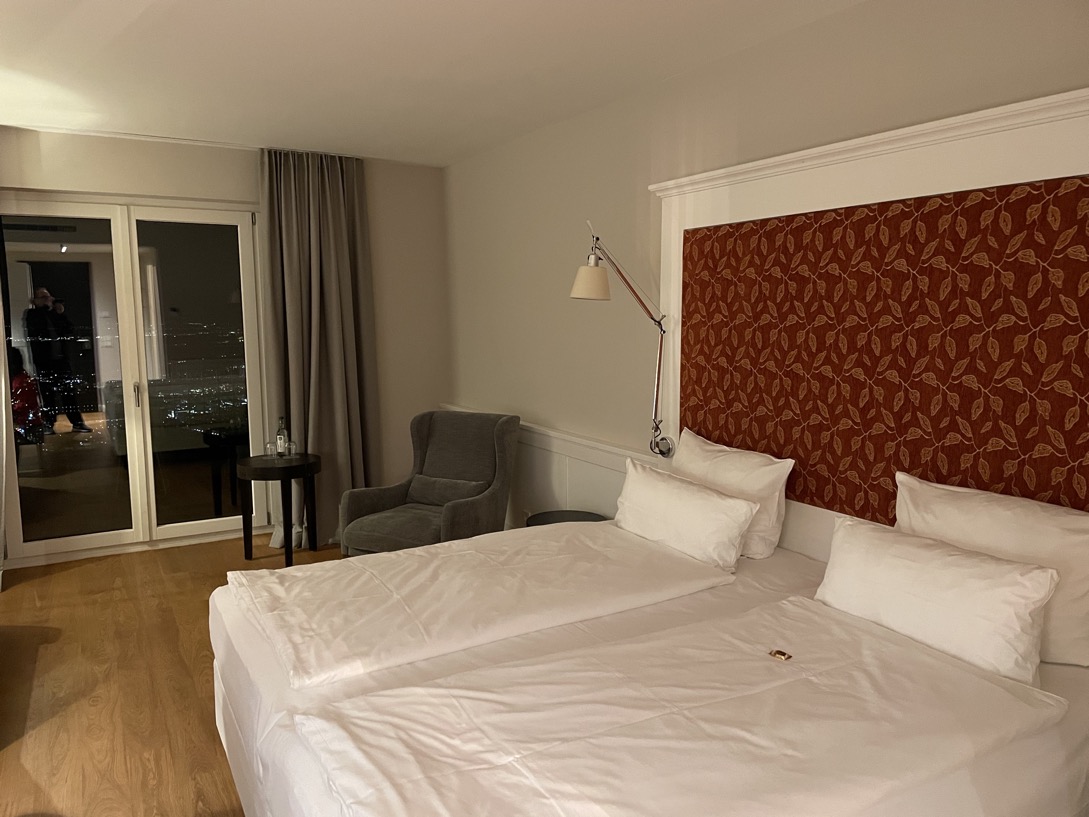
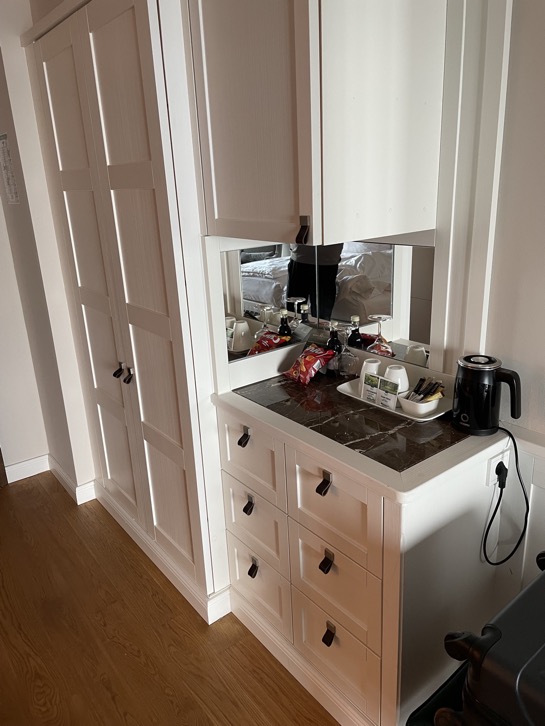

The bathroom oozed that little touch of luxury…with a big shower, a good sized handbasin and mirror, and the use of good quality materials.

The room terrace

One pleasant feature was the hotel room's private terrace. A pleasure we could not fully appreciate because it rained every day, and the air was quite cold. Actually we can only see a portion of the city from the terrace. The lower terminal of the Heidelberger Bergbahn is in Heidelberg Altstadt, and across Neckar the district Neuenheim is an attractive residential area. The district with a number of modern looking whitish buildings is Neuenheimer Feld, a more recent development linked to many of the university departments. We can see a big white chimney which is the tallest structure in the city, at 120 metres. It is a cogeneration thermal power station supplying heat, steam and electricity, with a district heating output of 162 MW and an electrical output of 13.5 MW.
The Neckar, a name that may have a Celtic origin, is the 4th largest tributary of the Rhine, and the 10th largest river in Germany.

Breakfast

Many reviews mention the excellent breakfast, which is probably a exaggeration. It's a good breakfast, offering many options, meats and cheeses, fruit and vegetables, eggs, omelettes, etc., and the usual pastries with an assortment of jams, etc.
Bergstube

The Bergstube is very nicely decorated as a kind of traditional Alpine family oriented restaurant, i.e. usually not overly sophisticated or expensive. It's on the lower ground floor and opens out on to a terrace overlooking Heidelberg. An important point for us was that it serves during the day (both lunch and tea and cakes), and was also open for dinner between 17:00 and 21:00.
The menu in German is quite complicated (an English version is available), and is focussed on traditional German food that might be found in a local "stube", i.e. a room for living in, often the heated part of a traditional farmhouse. And in this case our stube is sitting on a hill top (berg).

On the first evening I took the Fleischpflanzerl (meat balls), said to be from Hohenloher Landschwein, or country pig from the Hohenlohe region. It was served with Drillingskartoffeln (potatoes), sautierter Baby Spinat (sauteed baby spinach), and Zornickel-Senf hausgemacht (homemade hot mustard). These meat balls were more or less round, but they are essentially a type of Frikadellen you can find in any Schnellimbiss (fast food stand). Often a bit flatter, the story goes that German immigrants from Hamburg took their Frikadellen with them to the US, and then stuck it between two buns to make a Hamburger.
My Fleischpflanzerl (meat balls) were reasonably tasty, but nothing out of the ordinary, and they cost €17.90. My wife took a ½ Alpen-Landhuhn aus dem Rohr, with Bergfritten (mountain fries) and Sauerrahmdip (sour cream dip), costing €16.90. When prepared and cooked properly a nice free-range chicken can be a simple and tasty dish. But what they had done was to simply flatten a ½ chicken (supposedly from the Alpine lands) and roast it so that the skin became crispy (I think aus dem Rohr just means from the oven). The skin was crispy and chicken meat was not overly dry, but it had no real taste to it. I would have hoped that they would have vigorously rubbed the chicken skin with nice mix of olive oil, salt and tasty spices (e.g. paprika, pepper, curry, thyme, rosemary, etc.). The Bergfrtitten looked suspiciously like something from MacDonalds, but the Sauerrahmdip was tasty.
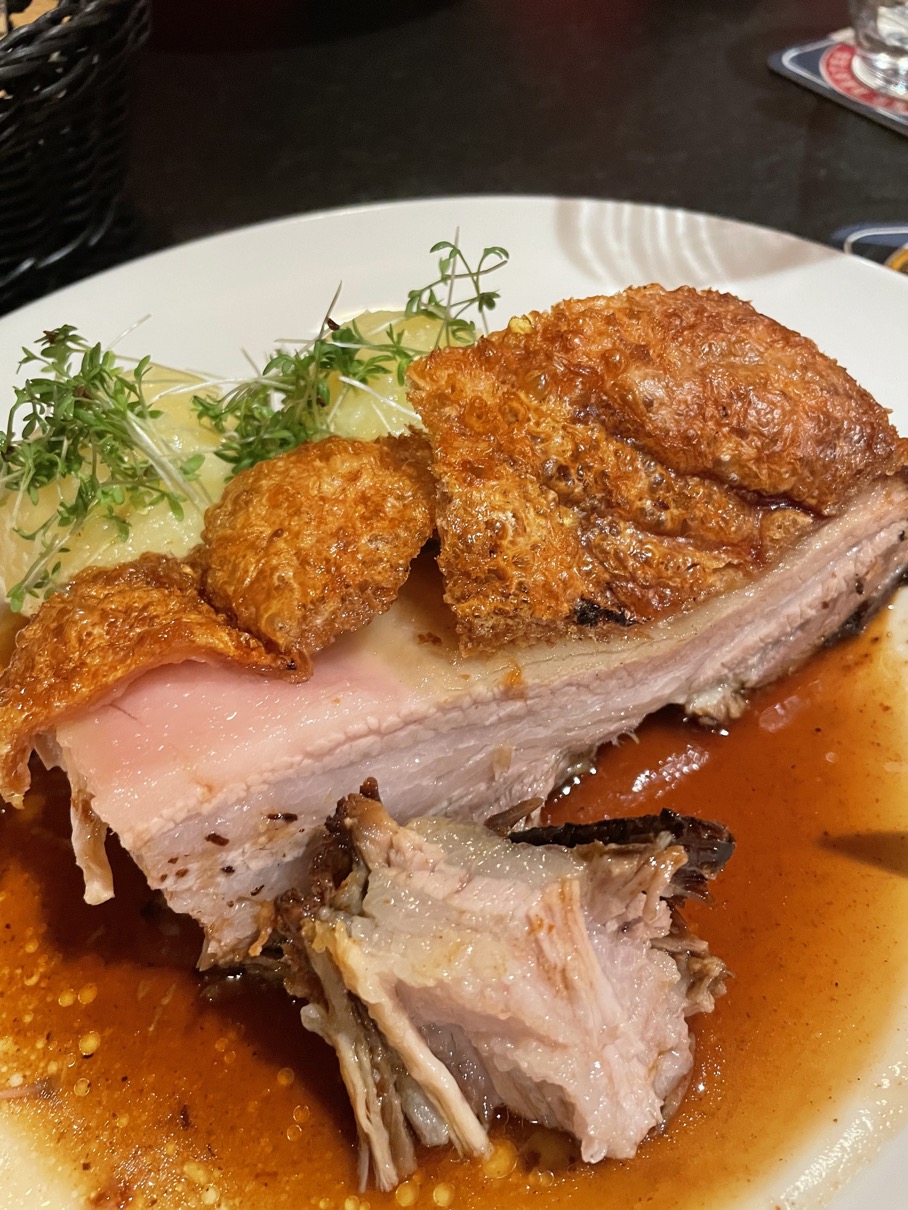
The next evening I took the Krustenbraten vom Schwäbisch Hällischen Schweinebauch (Pork Roast with Crackling from Swabian-Hall pork belly), with Kartoffelknödel (potato dumpling), Rotkrautsalat (red cabbage salad) and Dunkelbiersauce (dark beer sauce), cost €19.90. Now we are on to a true traditional German meal, and frankly my photograph might not do the dish full justice.
Around 1920 King Wilhelm I of Württemberg imported and bred some Chinese Meishan Pigs, a medium sized, very docile pig known for its tender and juicy meat with a very flavourful taste. The Swabian-Hall Pig is a reference to Schwäbisch Hall, the place where the breed has been kept alive, and today has a Protected Geographical Status. After slaughtering the pork belly is left to dry for about two weeks in salt ripening rooms (this procedure is called dry ageing).
The taste was really great, the crackling perfectly prepared, and the dark beer sauce was a great addition. However, as can be seen in the photograph, this is a meat with a lot of fat. The popularity of this meat is declining, as people prefer leaner pork with less fat. I admit I cut away a portion of the fat, but it was still an extremely flavourful dish (however I wouldn't eat it every day, or even every week).
You can also see in the photograph the Kartoffelknödel, or potato dumpling. There are a wide variety of different dimpling recipes, the ones presented with this meal were not light and fluffy, but more sticky and not that tasty (except with the dark beer sauce). Later we will see that similar dumplings can be sliced and fried, which I found a better option.
As with Kartoffelknödel the Rotkrautsalat, red cabbage salad, is a very traditional accompaniment with many German dishes. This cabbage can have a red colour or a more purple tone. In fact in the region of Heidelberg, a red/blue or more purple colour is common (although it's always called red cabbage). In Germany red cabbage is often served as an accompaniment to roast pork, goose, duck or sauerkraut, as well as with game.
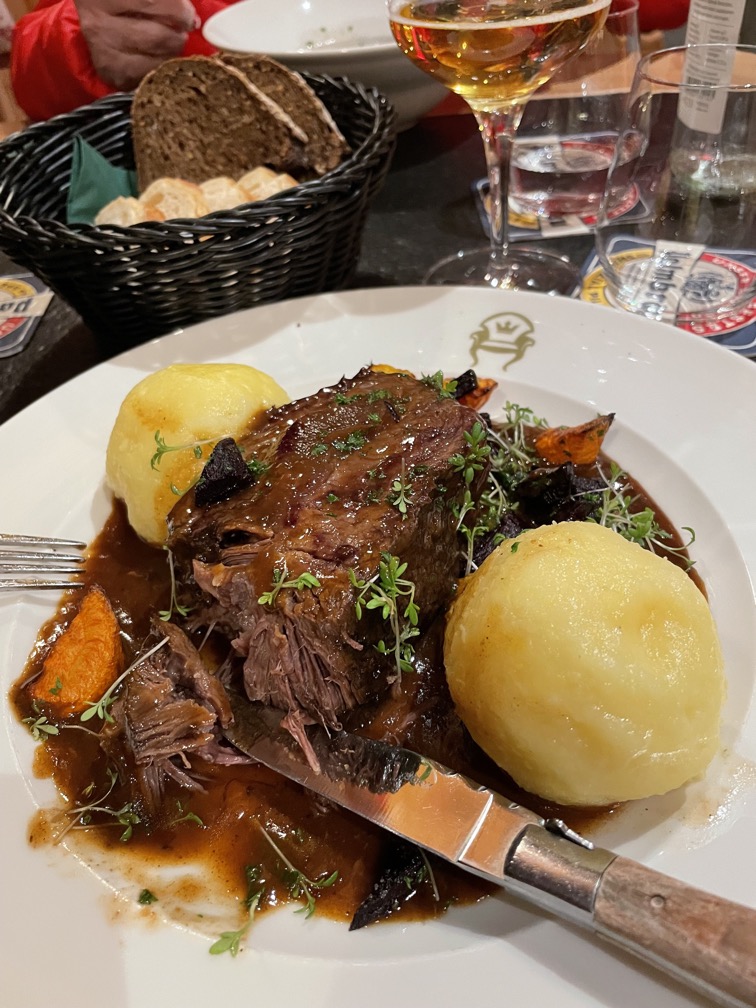
My third meal in the hotel Bergstube was Geschmorte Rinderschulter bunte Rüben (Braised Beef Shoulder with Turnips), with Kartoffelknödel (potato dumpling), costing €23.90. Again my photograph does not do the dish full justice, since it presented very well on the table. Great taste, but I would have preferred more turnips, etc. and just one dumpling.
The beef shoulder ("primal chuck" or "clod") is one of the least expensive cuts due to muscle (tough connective tissue) and fat, but it is much appreciated for its good beef flavour and meaty texture when cooked properly. At its best it's a boneless cut from the area where the clod meets the edge of the pectoral muscle, so a mix of tender and well-worked muscle, with a good consistent marbling and a visible coarse texture. It is not a "melt in your mouth" piece, and can contain some gristle.
"Pulled beef" braised for several hours at a low temperature is a traditional German dish, but one that has again become quite fashionable. It should be so tender that you can pluck it apart just with a fork. People have learned that you can throw almost anything in with the meat (vegetable mixes), and serve it with a variety of sauces, salads, toasted breads, rice, etc. And once the lid is on it can simmer for 3, 4 or even 5 hours, with only a quick check to see that it's not drying out.
The usual idea is to prepare a mix of smallish cuts of onions, carrots, turnips, garlic, etc., and caramelise them in a medium-high heat in a large casserole dish (often the mix is left first to marinate in the fridge overnight). To this you might add some tomato paste, and/or brandy and/or wine, and reduce, and then finally add chicken broth. Now you add a good size cut of beef shoulder and let it simmer just below boiling point for at least 3½ hours, turning the meat occasionally to ensure that it does not dry out. Some cooks salt the meat and fry it for about 10 minutes, before simmering. Others prefer to braise the meat in the roasting pan placed in the lower half of the oven. Near the end you can add garlic, ginger, lemon and/or orange zest, bay leaves, olives, cloves, etc. The cooked meat is removed and wrapped in foil to keep it warm. The remaining juice can be deglazed and sieved, and left to simmer for about ½ hour with some glazed vegetables, e.g. turnips. Butter is added, then the juice is simmered until it is slightly thicker, but not too much. As you can guess there is a lot of possibilities to customise the marinade and juice, and add other side vegetables such as glazed carrots (bunted karotten), or even polenta or a potato gratin (kartoffelgratin). Presentation can also vary. Here the cut was served whole, but other cooks might serve it sliced across the grain.
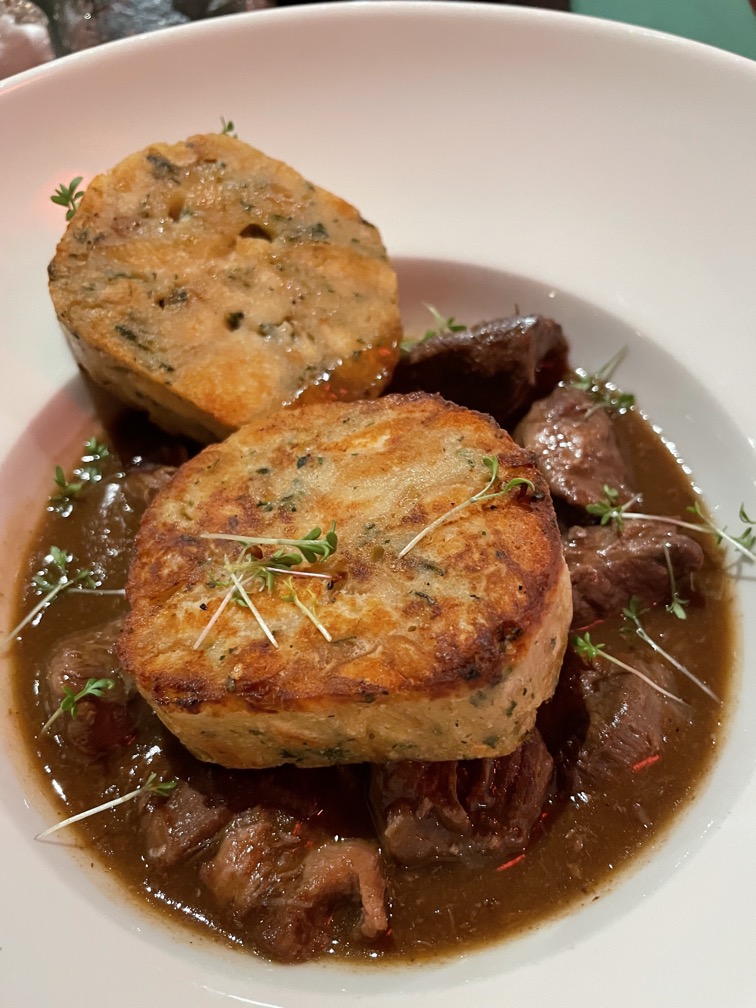
My final meal in the hotel Bergstube was a very tasty Odenwälder Wildgulasch (Odenwälder Venison Goulash), with gebratene Brezelknödel (fried pretzel dumplings), and the inevitable Rotkrautsalat (red cabbage salad), costing €23.90.
The Odenwald region is quite a large area to the north-east of Heidelberg, but there is also a smaller area called the Kleiner Odenwald just east of Heidelberg on the Neckar (the Königstuhl is actually part of this smaller area). Venison is deer, and goulash is just a meat stew, hopefully with some added paprika for taste.
Pretzel dumplings are dumplings made from broken up pretzels. The pieces are mixed with hot milk, chopped onions, butter, chopped parsley, egg, nutmeg, salt and pepper, etc. They are cooked in water, then cut into slices and fried. Nice choice, quite tasty with the goulash.

The Bergstube offered a few dessert options. I tried the Weissbier-Tiramisu (wheat beer Tiramisu) with Blaubeeren (blueberries) and Schokoladenstreusel (sprinkled chocolate), and the Mandel-Biskuit (almond sponge cake) with Karameil (caramel) and grünes Apfel Sorbet (green apple sorbet). The first cost €9.90 and the second €8.90. We can see the Mandel-Biskuit above, but frankly neither desserts were convincing. This was the case where looks were not followed up by taste. You could taste each component, but nothing stood out, and the combinations did not convince me. After these two trials, I followed my wife's example, and just took two scopes of ice cream for dessert.
As I tried the four dishes mention above, my wife preferred a soup and a local sausage with baby potatoes.
Luckily we were only in Heidelberg four days, because I don't think I would have tried any of the above mentioned meals again (although at a pinch I might have tried the Wildgulasch again). More likely, I might have gone for one of the Vegan options, since the Bergstube did offer seven different possibilities.
I would have liked to see a couple of "international" options, e.g. Wiener schnitzel, curry, etc. There was one fish dish (i.e. cod), but I would have preferred a salmon dish or two.
All these meals were washed down with a couple of the local pils, from Palmbräu. I did think that €3.60 for a 0.3 litre pils was reasonable, but I felt that €6.90 for a bottle of still water was a bit expensive.
Review Summary
Positives were:-
The location of the Königstuhl hotel means you have a fantastic view over Heidelberg
The Heidelberger Bergbahn just next-door is particularly practical (although we did not have time to try it)
The hotel was opened in 2021 so the rooms are almost new
The built finish in the room and on-suite was very good (as you would expect in a newly built 4-star hotel)
The room decoration was comfortable, but I think it could have been a little more colourful, e.g. the nice red headboard was a good example
The on-suite was perfect with a good sized walk-in shower, but my wife always likes having a bidet (the finish in the bathroom was possible even better than you might expect for a 4-star hotel)
The room was properly equipped for a 4-star hotel, i.e. wardrobe space, adequate wooden coat hangers, wall-safe, fridge, air-conditioning, good mirror, decent sized flat-screen TV, good sized desk, comfortable seating, support for the suitcase, side table, etc.
The on-suite had the usual amenities with a good shower, but when we used the shower cap it was not replaced
The bed was very comfortable, and the bedside lamps were fantastic and very practical
The room had good lighting options
Having a covered hotel parking was useful, even it was not directly accessed from inside the hotel (not sure how secure it was since it is not closed and I didn't see any cameras)
The staff were professional, and booked taxi's for us as needed
The house keeping appeared to be very good
The breakfast buffet was good, nice selection, more than enough for our needs
The Bergstube is very nicely decorated, and opening at 17:00 for dinner was a good practical option
4G reception was flaky, but the hotel wifi was fine.
My negatives were:-
Some people might complain about the difficulty to find the hotel, and I sympathise since it was more difficult than I had anticipated
Only half of the rooms have views over Heidelberg, and I can understand some guests being disappointed given that half the rooms have views over the open hotel parking at the back
The fittings are quite modern, e.g. contactless key, etc., so I was surprised not to find any USB charging points
There was an electric kettle in the room, with two tea bags (one black tea and one peppermint tea, plus some Nescafe Gold instant coffee, powdered milk and sugar), but no Nespresso coffee machine
For some (international) hotels guests the food options in the Bergstube could be limited and possibly "overly local heavy German food", and not with any of the usual international options (however there were several Vegan options)
The wall safe was a good size and easy to use, but it was placed on the top shelf of the wardrobe, which might prove challenging for smaller people or those with limited agility
The bathroom amenities were from "Saint Charles Apothecary" from Italy (never heard of them), and included hand soap, shampoo and conditioner, but no shower gel
The air conditioning/room heating appeared to blow warm and cool air at will, and I was not convinced that it was working properly
The terrace seating collected water, making them unusable even if the weather improved
One of the sockets over the desk did not work.
Overall conclusion
A very good 4-star hotel in a great place overlooking the city, but I found our stay a bit expensive at over €1,300 for 4 nights, albeit with meals included. Having concluded that, I don't know what a 4-night stay might have cost in Heidelberg innerstadt. And I accept that I had to pay a little more for a less conventual hotel experience. I suppose the real question is, would I return? And the answer is yes, I would certainly not rule out a revisit in the summer months, but in winter I would probably try harder to find a hotel in the city.
Towers on the Kõnigstuhl
On top of Königstuhl, just behind the hotel, there are two towers. The nearest tower is the Fernsehturm Heidelberg, which originally was a 30 metre tall water tower with an open-air observation deck (with an elevator). Originally built in 1958 and owned by the city, it was sold to Sūdwestrundfunk (SWR), and converted into an 82 metre tall transmission tower for digital TV channels (as well as FM and DVB-T channels). Not sure if its still a water tower, but the observation deck was permanently closed in 2002.
The second tower is a 102 metre tall Deutsche Telecom Telecommunication Tower, also built in 1958.

On the first tower (below left) I think we can see the DAB/TV dipoles on the upper part of the tower, and the side mounted FM radio transmitters on the lower part of the tower. We can also see the detail of the old water tower and open observation platform.
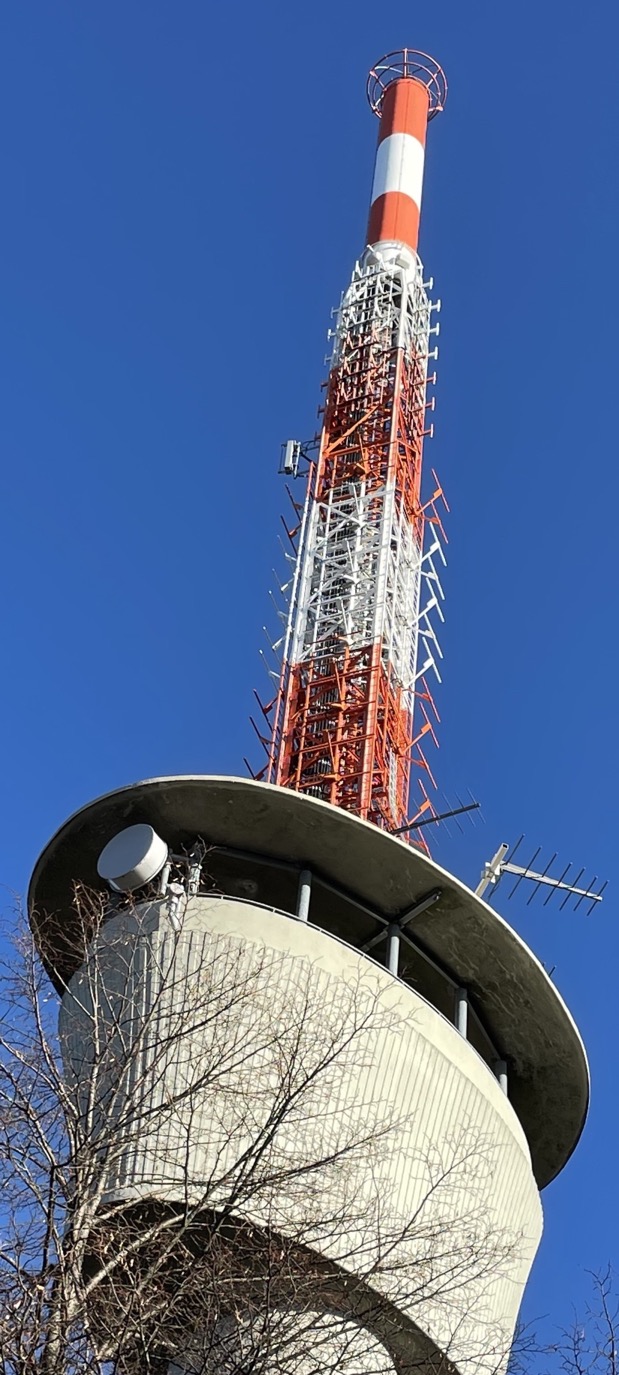

I'm not sure, but its possible that the telecommunications tower (above right) is no longer used, or is only dedicated to mobile phone transmission (analogue TV transmissions are closed down, and digital TV is transmitted from the other tower).
A bit further away there is a third telecommunications tower originally used by the US armed forces, but returned to the state of Baden-Württemberg in mid-2007.